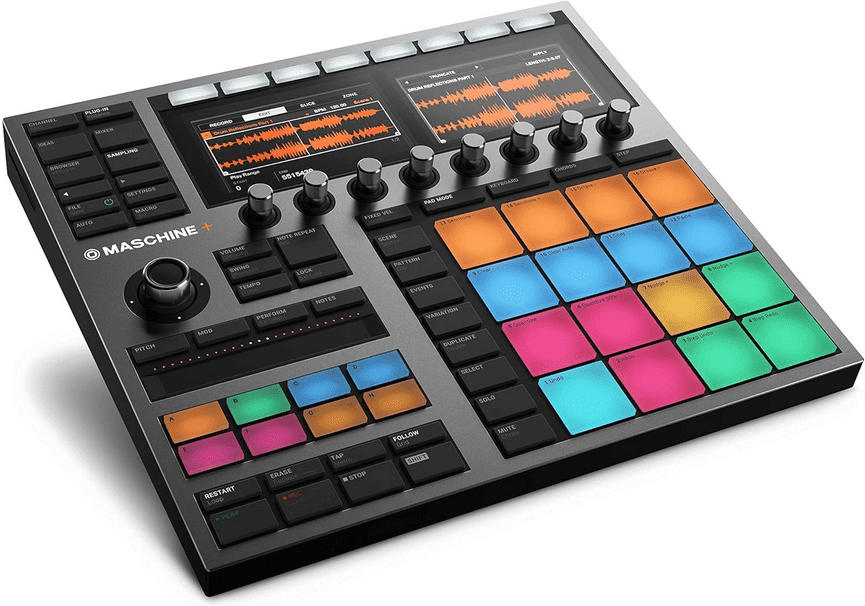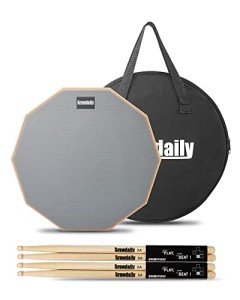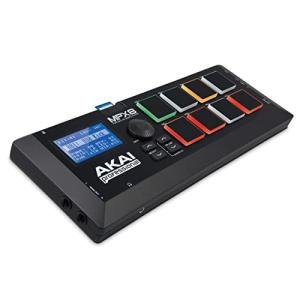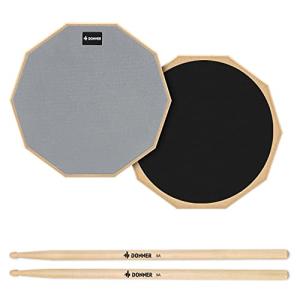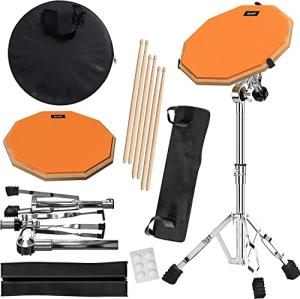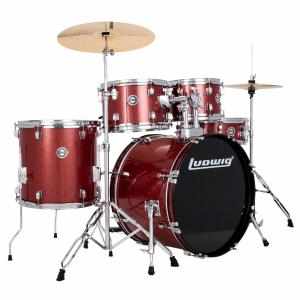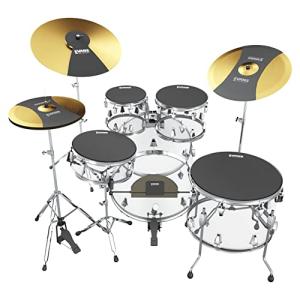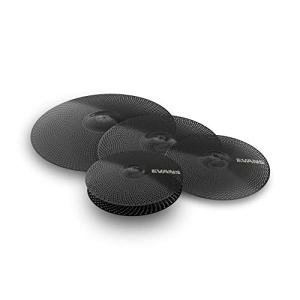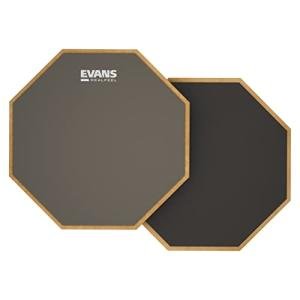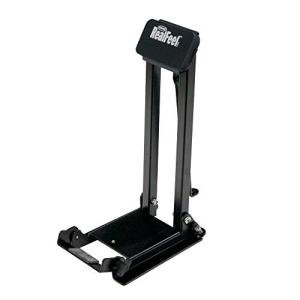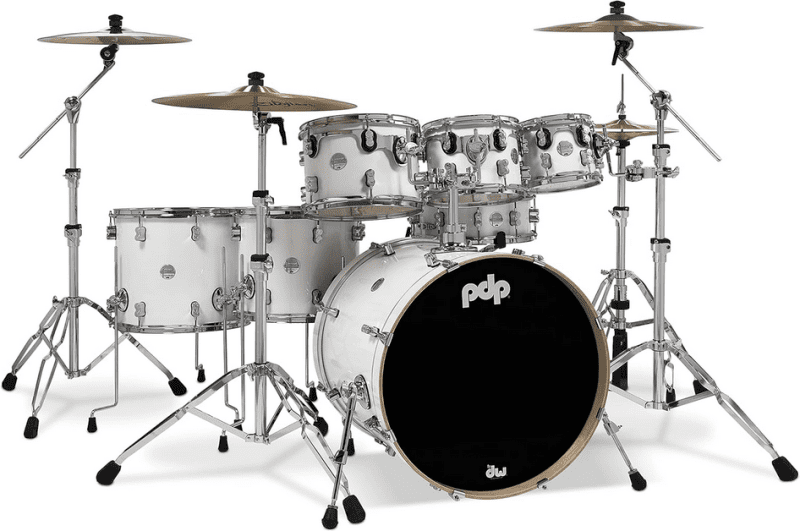Fun and inventive methods to keep your drumming skills on point:
Drumming is an art that needs constant practice to master. But, not everyone can always have a drum set. The SMA says, "practicing the drums doesn’t always have to include a drum set." This is great for beginners, those looking to buy a drum set, or anyone who wants to keep it quiet.
There are many percussion practice techniques and drum pad exercises to keep drummers sharp without a full set. These methods are not only easy but also help improve drumming skills.
Key Takeaways
- Drumming practice doesn't require a full drum set.
- Percussion practice techniques can be done anywhere.
- Drum pad exercises are effective for improving drumming skills.
- Minimizing noise is a significant advantage of practicing without a drum set.
- Beginners can start practicing with simple exercises.
The Challenges of Drumming Without a Kit
As London Drum Institute says, "being kit-less doesn’t mean beat-less!" This is true for drummers who practice without their kit. They face many obstacles when trying to practice without their drum set.
Common Obstacles Drummers Face
Drummers often encounter problems such as space limitations and noise restrictions when practicing without a kit.
Space Limitations
Drummers often struggle with limited space. Many live in apartments or shared spaces where a full drum kit is not possible.
Noise Restrictions
Another big challenge is noise restrictions. Drumming can be very loud. Without a kit, finding quiet ways to practice is key to not disturb others.
12” Drum Practice Pad with Sticks & Storage Bag
Perfect for honing your drumming skills anywhere you go!
Product information
$22.97
Product Review Score
4.49 out of 5 stars
63 reviewsProduct links
Why Consistent Practice Matters
Consistent practice is key for drummers, even without a kit. It keeps muscle memory sharp and prevents skill degradation.
Muscle Memory Maintenance
Regular practice, even without drums, keeps muscle memory sharp. This can be done through air drumming or using a practice pad.
Skill Degradation Prevention
Without regular practice, drumming skills can fade. Engaging in drumming exercises or mental practice can prevent this from happening.
By knowing these challenges and practicing regularly, drummers can stay sharp even without a drum set.
Essential Tools for Drumless Practice
Drummers can keep practicing even without a full drum kit. The right tools and equipment are key. Creativity and the right gear help keep your skills sharp.
Practice Pads: Types and Benefits
Practice pads are crucial for drummers without a kit. Drumeo Beat says they are every drummer's best friend. They come in single pads and multi-pad systems.
Single Pads vs. Multi-Pad Systems
Single pads focus on a specific technique. Multi-pad systems offer versatility. They let drummers practice complex patterns and grooves.
Mesh vs. Rubber vs. Silicone
Practice pads are made from mesh, rubber, and silicone. Each material feels and responds differently. Mesh pads are quiet and responsive, while rubber pads are durable.
Sticks, Brushes, and Mallets
Choosing the right sticks, brushes, and mallets is key. Different materials and sizes change the sound and feel of your practice.
Choosing the Right Tools
When picking sticks, think about the material and size. Brushes and mallets also vary in size and material. Each is suited for different techniques and styles.
Metronomes and Timekeeping Devices
Metronomes are vital for improving timing and rhythm. They help drummers develop a strong sense of tempo and timing.
Digital vs. Analog Options
Metronomes are digital or analog. Digital ones have adjustable tempo and time signatures. Analog ones offer a traditional practice experience.
| Tool | Type | Benefits |
|---|---|---|
| Practice Pads | Single Pads, Multi-Pad Systems | Ideal for rudiment practice, versatile practice experience |
| Sticks, Brushes, Mallets | Various materials and sizes | Suited for different techniques and musical styles |
| Metronomes | Digital, Analog | Improves timing and rhythm, adjustable features |
AKAI MPX8 Portable Sample Pad Controller
Elevate your music production with this compact and versatile sample pad designed for creativity on the go
Product information
$119.00
Product Review Score
4.56 out of 5 stars
134 reviews
Product links
AKAI MPX8 Portable Sample Pad Controller
Elevate your music production with this compact and versatile sample pad designed for creativity on the go
Product information
$119.00
Product Review Score
4.56 out of 5 stars
134 reviewsProduct links
Creating a Portable Practice Setup
Drummers who are always on the move need a portable practice setup. It lets them keep their skills sharp anywhere, from small apartments to outdoor spots.
Minimal Setups for Apartments
In apartments, a small setup is key to keep the noise down. Silent practice solutions are a must. Use a practice pad or a silent drum pad with mallets or brushes.
Silent Practice Solutions
Electronic drum pads or apps are great for silent practice. They're perfect for those who live in apartments and want to practice without disturbing others.
Donner 8-Inch Silent Drum Practice Pad with Sticks
Perfect for quiet practice anytime, anywhere
Product information
$19.99
Product Review Score
4.66 out of 5 stars
191 reviewsProduct links
Travel-Friendly Options
Traveling drummers need gear that's easy to carry and lasts long. Collapsible and packable equipment is the best. Look for practice pads and sticks made for travel.
Collapsible and Packable Equipment
Collapsible drum pads and packable sticks are great for drummers always on the move. They're made to be small and light.
Budget-Conscious Alternatives
Not everyone can spend a lot on practice gear. DIY practice tools are a budget-friendly option. You can make your own practice pad with things you have at home.
DIY Practice Tools
Making your own practice tools can be fun and rewarding. Use rubber mats or old CDs to make a makeshift practice pad.
SLINT Drum Pad Stand Kit - Dual Surface Practice
A versatile and sturdy stand kit for drum pad practice sessions with dual surfaces for improved playing experience
Product information
$64.99
Product Review Score
4.44 out of 5 stars
164 reviewsProduct links
Body Percussion Techniques

The London Drum Institute says, "Your body is a built-in percussion instrument." This is a cool way to practice drumming without a drum set. Using different parts of your body can boost your coordination, rhythm, and musicianship.
Hand and Foot Coordination Exercises
Drummers need to work on hand and foot coordination. You can do this by clapping hands and stomping feet in different rhythms. Limb independence is key to mastering these exercises.
Limb Independence Drills
Try this drill to improve limb independence: Clap hands on beats 1 and 3, and stomp feet on beats 2 and 4. As you get better, add more complex rhythms with your hands and feet.
Creating Rhythms with Your Body
Creating rhythms with your body means using different parts to make sounds. For example, try slapping your thighs, clapping your hands, or stomping your feet. Experimenting with different body percussion techniques can help you find your unique rhythmic patterns.
Beatboxing for Drummers
Beatboxing is a great way to practice drumming without a kit. It's about making drum-like sounds with your mouth, lips, and vocal cords. This can help improve your timing and rhythmic accuracy.
Translating Body Percussion to the Drum Set
Once you've mastered body percussion, you can easily use it on the drum set. The coordination and rhythmic skills you've developed will make your drumming better. Mental mapping is a useful strategy for transferring body percussion to the drums.
Mental Mapping Strategies
Mental mapping involves visualizing the drum set and connecting body percussion movements to drumming actions. For example, if you're clapping a rhythm with your hands, think of it as playing the snare drum or toms.
| Body Percussion Technique | Drum Set Equivalent | Benefits |
|---|---|---|
| Hand Clapping | Snare Drum | Improves Timing |
| Foot Stomping | Bass Drum | Enhances Coordination |
| Thigh Slapping | Toms | Develops Rhythmic Accuracy |
"The body is a powerful instrument that can be used to create complex rhythms and improve drumming skills."
Household Items as Percussion Instruments
Drumming isn't just for drums. It's about finding rhythm in everyday things. Drumeo Beat says, "Everything around you is now a drum!" This idea lets you turn household items into drums for fun and practice.
Kitchen Implements as Percussion
Your kitchen is full of things that can make music. Pots, pans, and utensils can all create different sounds.
Pots, Pans, and Utensils
Try using different sizes and types of pots and pans to get different sounds. Metal colanders, wooden spoons, and metal utensils can add more depth to your drumming.
Furniture and Everyday Objects
But it's not just the kitchen. Other household items can also become drums. Chairs, tables, and even bookshelves can join your drumming setup.
Creating Different Tones and Textures
Changing what you hit and its material can make a wide range of sounds. For example, hitting a wooden table with a stick sounds different from hitting a glass surface.
Building a "Found Sound" Kit
Make a "found sound" kit with the items you've found. It's a fun way to practice drumming without actual drums.
Organizing Your Makeshift Setup
Set up your items like a real drum kit. You can arrange pots and pans in a circle. Keep different utensils nearby to use as drumsticks or mallets.
| Item | Sound Produced | Potential Use |
|---|---|---|
| Pots and Pans | Deep resonant tones | Bass drum or tom |
| Metal Utensils | Sharp, crisp sounds | Snare or hi-hat |
| Wooden Spoons | Soft, muted tones | Soft percussion or brush strokes |
Using household items as drums keeps your practice going. It also lets you find new ways to be creative. This approach boosts your skills and encourages you to think outside the box.
Practicing Without a Drum Set: Creative Ways to Stay Sharp

Drumming skills can be honed without a drum set. There are creative ways to practice and get better. Drummers can use various techniques to keep their skills sharp, even without a full drum kit.
Mental Practice Techniques
Mental practice is a strong tool for drummers. It involves seeing yourself play complex rhythms and techniques. This helps strengthen your muscle memory and boosts your drumming skills.
Visualization Exercises
Visualization exercises help you imagine playing a piece or technique. Find a quiet, comfy spot to sit and close your eyes. Picture the drum setup and imagine your hands and feet moving in sync.
Pay attention to details like stick height, foot placement, and sound. This makes your mental practice more effective.
Air Drumming with Purpose
Air drumming is a great way to practice without a drum set. It's not just about mimicking the motions. It's about doing it with purpose and precision.
Technique Refinement Through Motion
When air drumming, focus on improving your technique. Pay attention to your posture, hand positioning, and limb motion. Practice rudiments, grooves, and complex patterns with controlled and precise movements.
Listening and Analysis Methods
Listening to and analyzing drumming performances is valuable. It helps you develop your ear and understand different techniques and styles.
Transcribing Drum Parts
Transcribing drum parts from your favorite songs or recordings is a great way to improve. It involves listening carefully and notating or memorizing the rhythms and techniques. This practice enhances your ability to recognize and replicate complex patterns.
By using these methods in your practice routine, you can stay sharp and improve your drumming skills, even without a drum set.
Digital Solutions for Drum Practice
In today's digital age, drummers have many tools to enhance their practice. They don't need a physical drum set. Technology has made it easy for drummers to keep and improve their skills.
Drum Apps and Software
Drum apps and software are very popular. They offer interactive learning platforms with lessons and exercises for all skill levels.
Some apps provide interactive lessons and exercises to boost technique. They're great for drummers who want to practice without a physical kit.
Interactive Learning Platforms
Many drum apps and software have interactive learning platforms. They offer structured lessons and exercises for different learning styles.
Virtual Drum Kits
Virtual drum kits let drummers practice without a physical set. They can be used with MIDI controllers and triggers for a real drumming feel.
MIDI Controllers and Triggers
MIDI controllers and triggers are key for virtual drum kits. They connect digital kits to computers or mobile devices, opening up creative possibilities.
Online Resources and Communities
The internet has many resources and communities for drumming. Drummers can find video lessons and join forums to share and learn.
Video Lessons and Forums
Video lessons offer visual guidance. Forums are for discussion and feedback. These online tools are very helpful for improving skills.
| Digital Tool | Description | Benefits |
|---|---|---|
| Drum Apps | Software for mobile devices or computers | Portable, interactive lessons |
| Virtual Drum Kits | Digital versions of drum kits | Space-saving, versatile |
| Online Resources | Video lessons, forums, and communities | Access to a wealth of information, community support |
Drummers can keep and improve their skills with digital tools, even without a physical drum set. Apps, virtual kits, and online communities offer many ways to practice and grow.
Technique Maintenance Without Drums
The London Drum Institute says practicing rudiments and stick control exercises keeps technique sharp. This way, drummers can stay in top form even without their full kit.
Stick Control Exercises
Stick control is key to drumming. Exercises that focus on stick control can be done with just sticks and a pad or hard surface.
Adapting Classic Methods
Classic stick control methods, like George L. Stone's, can be practiced without a drum set. For example, practicing stroke types and timing with a metronome improves control and timing.
Rudiment Practice Adaptations
Rudiments are the foundation of drumming. Practicing rudiments without a drum set means focusing on stroke types and rhythmic patterns.
Single, Double, and Buzz Stroke Maintenance
It's important to keep single, double, and buzz strokes sharp. Drillers can practice these strokes on a pad, focusing on evenness, dynamics, and speed.
Hand and Foot Independence Drills
While a drum set isn't needed for all hand and foot independence drills, some can be adapted. For example, practicing hand techniques with sticks on a pad and foot techniques on a pad or even tapping on the floor.
Coordination Exercises Without Pedals
Coordination exercises that don't need pedals include clapping or tapping hands to a rhythm while tapping feet to another. This improves overall coordination and independence.
By incorporating these exercises into their regular practice routine, drummers can maintain and even enhance their technique without needing a full drum set.
Rhythm Training Away from the Kit
Rhythm training is key for drummers and can be done anywhere, anytime. You don't need a drum set. Drumeo Beat says, "Rhythm training is essential for drummers." This shows how vital it is to work on rhythm skills away from the drum kit.
Counting and Subdivision Exercises
Counting and subdivision exercises are basic but crucial. They help drummers get better at timing and rhythm.
Vocalizing Rhythms
Vocalizing rhythms is a simple yet effective way to practice rhythm without a drum kit. Drummers can vocalize complex rhythms to improve their timing and coordination.
Polyrhythm Practice Methods
Polyrhythms are an advanced aspect of rhythm training. Practicing polyrhythms helps drummers improve their hand and foot independence.
Clapping and Tapping Techniques
Clapping and tapping techniques are useful for practicing polyrhythms. Drummers can clap with their hands and tap with their feet to develop complex polyrhythms.
Groove Internalization Techniques
Internalizing grooves is crucial for drummers to play with feel and confidence. One effective method is playing along with recordings.
Playing Along with Recordings
Playing along with recordings helps drummers develop their timing and groove. Drummers can practice playing along with their favorite songs to improve their skills.
To further illustrate the effectiveness of these techniques, let's look at a comparison of different rhythm training methods:
| Method | Description | Benefits |
|---|---|---|
| Counting and Subdivision | Exercises to improve timing and rhythm | Improved sense of timing, better rhythm |
| Polyrhythm Practice | Practicing complex polyrhythms | Enhanced hand and foot independence |
| Groove Internalization | Internalizing grooves through practice | Better feel and confidence while playing |
Keeping Your Drumming Passion Alive Without a Kit
Drummers can keep their passion alive by using creative practice methods. Even without a drum kit, you can stay sharp. The London Drum Institute says, "not having a drum kit doesn’t mean you can’t practice!"
Try drum practice methods without drums to improve your skills. You can use body percussion, household items as percussion, and digital solutions. These methods keep your technique sharp and help you understand rhythm better.
Adopting these creative ideas keeps your drumming passion alive, even without a kit. Staying committed makes you a more versatile and skilled drummer.
FAQ
Q: What are some creative ways to practice drumming without a drum set?
A: You can use practice pads and body percussion. Household items can also be turned into percussion instruments. Mental practice, air drumming, and digital tools like drum apps are other options.
Q: How can I maintain my drumming technique without a drum set?
A: Stick control exercises and rudiment practice can help. Hand and foot independence drills are also key. Use a practice pad or other surfaces to practice strokes.
Q: What are some effective ways to improve my timing and rhythm without a drum set?
A: A metronome can help with timing. Counting and subdivision exercises are also useful. Try polyrhythm practice and groove internalization. Playing along with recordings or using drum apps can also help.
Q: Can I use household items as percussion instruments?
A: Yes, you can. Kitchen implements, furniture, and everyday objects can create different sounds. Build a "found sound" kit and practice your drumming skills.
Q: Are there any digital solutions for drum practice?
A: Yes, there are many digital tools. Drum apps, software, and virtual drum kits are available. These tools can help you practice and connect with other drummers online.
Q: How can I stay motivated and keep my drumming passion alive without a kit?
A: Set goals and practice regularly. Explore new techniques and styles. Connect with other drummers online, watch videos, and attend events to stay inspired.
Q: What are some tips for creating a portable practice setup?
A: Use a practice pad, sticks, and minimal equipment. Consider compact practice pads and foldable music stands for travel.
Q: How can I practice drumming without disturbing others?
A: Use silent practice solutions like practice pads or electronic drum sets. Practice during less busy hours or use soundproofing materials.
Ludwig Accent 5-Piece Drum Set - Red Sparkle
Shop the Ludwig Accent 5-Piece Drum Set in Red Sparkle for stunning sound and striking style
Product information
$599.00
Product Review Score
4.3 out of 5 stars
85 reviewsProduct links
Donner 8-Inch Silent Drum Practice Pad with Sticks
Perfect for quiet practice anytime, anywhere
Product information
$19.99
Product Review Score
4.66 out of 5 stars
191 reviews